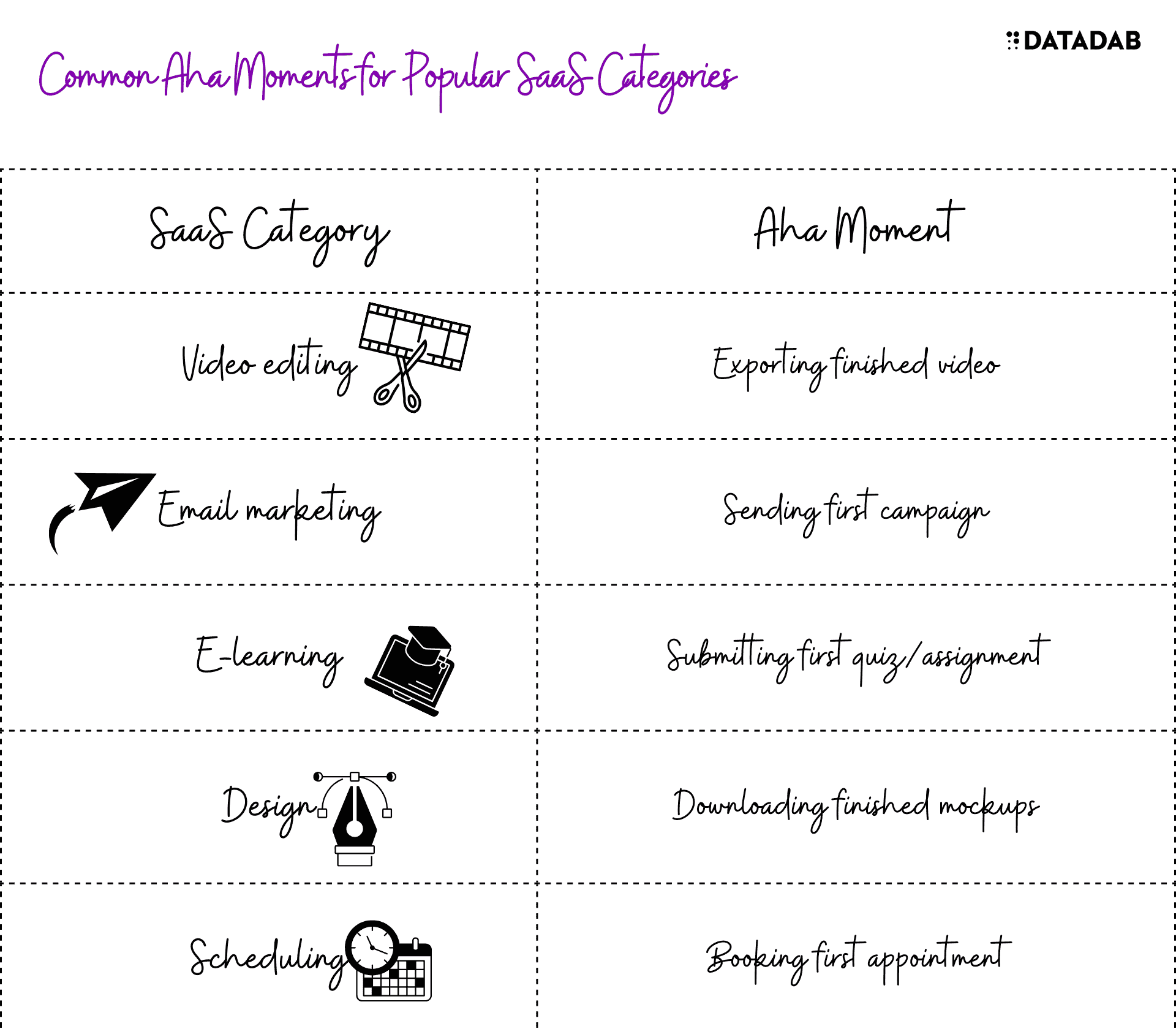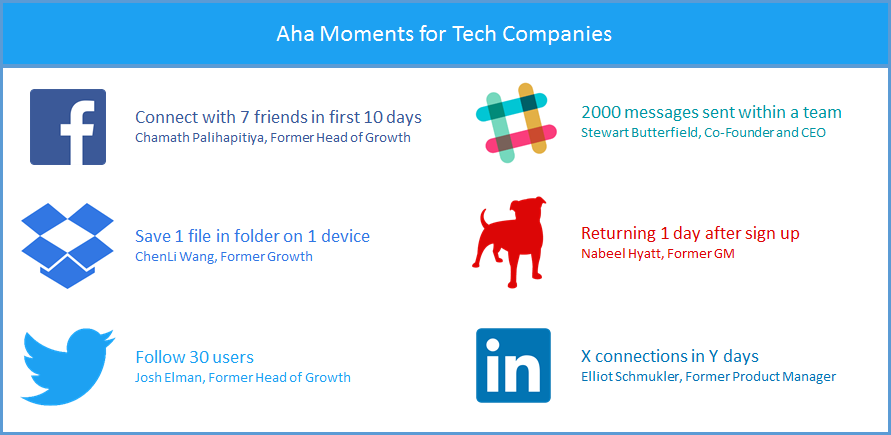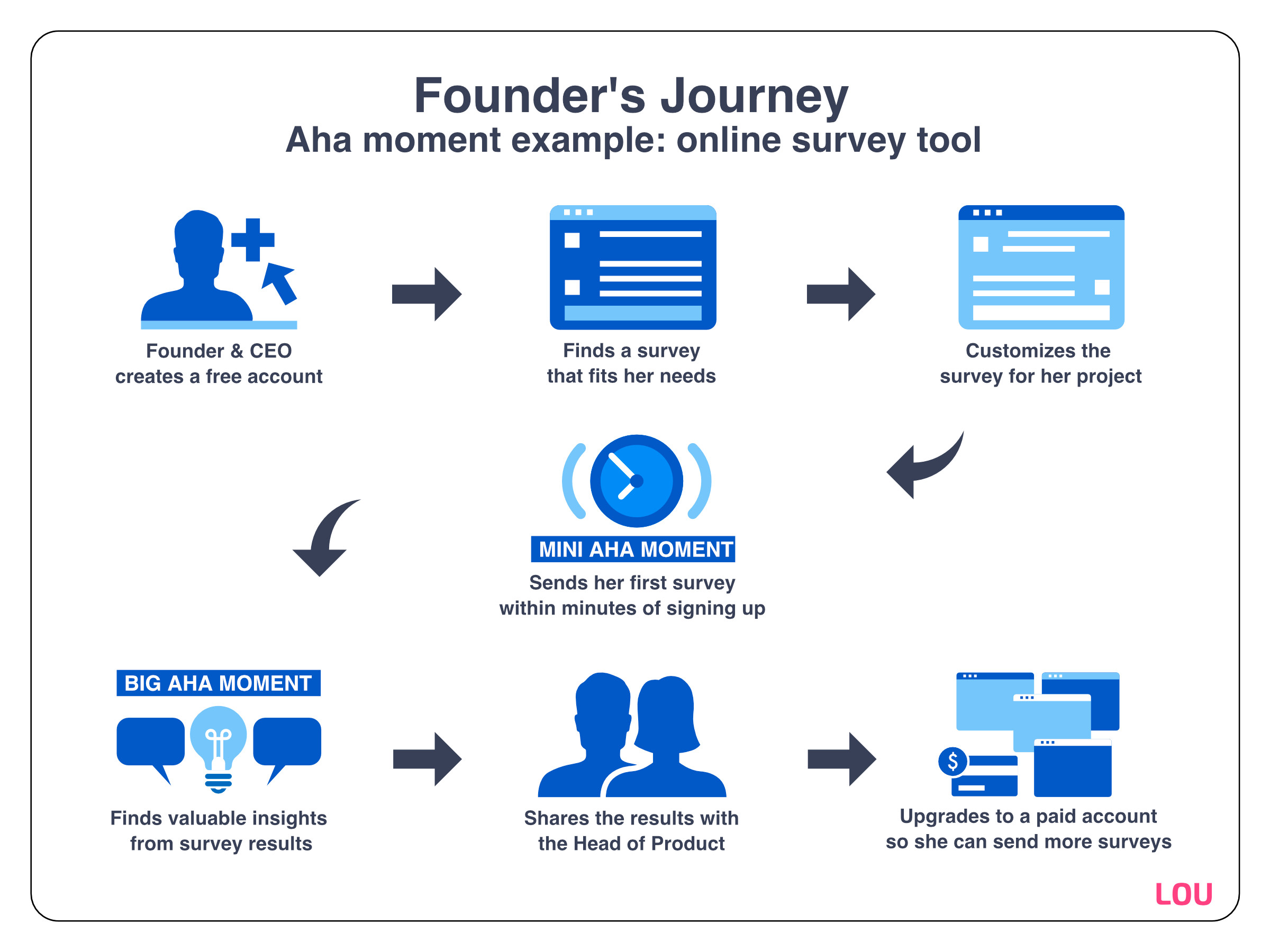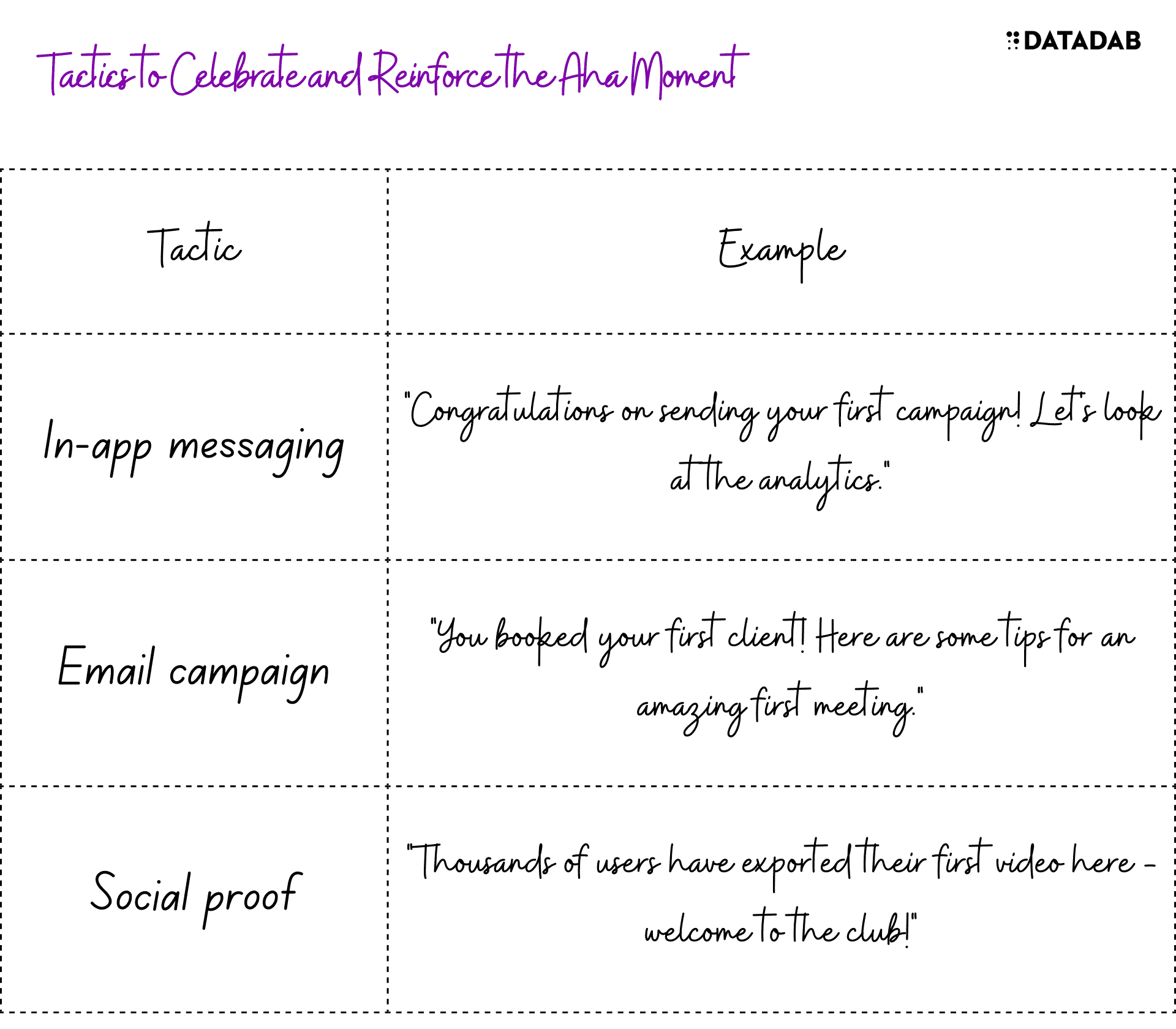“Don’t assume your product is self-evident, no matter how easy you make it. Identify the precise moment new users get it."
In my early days of marketing, I didn’t grasp the importance of pinpointing this Aha moment. But after seeing too many customers struggle to activate and churn soon after signup, I knew something was missing. The Aha Moment changed everything once I figured out how to identify it and go all out for it.
In this brief but solid guide drawn from my experience in the SaaS trenches, I’ll provide specific tactics on how to find the Aha Moment in your product and shape the entire user experience to drive new customers there as fast as possible. I’ll share real examples and hard-won lessons from both my wins and failures. My goal is to help you gain the same competitive advantage that a laser focus on the Aha Moment gave me and my clients.
When users experience that lightning bolt “Yes, this is it!” realization of value from your product, it changes everything. Let’s make sure they get there.

What is the Aha Moment?
The “Aha Moment” is the crucial instant when a new user of your SaaS product first successfully completes the core action that delivers the primary value proposition of your product. This is when the light bulb goes off and the user understands concretely how your product can impact their life or work.

Some examples of potential Aha Moments:
- A video editor exports their first finished video in a SaaS editing platform
- A sales rep sends a customized email campaign using a SaaS email marketing platform
- A student submits their first quiz using a SaaS e-learning platform
The Aha Moment is unique to each SaaS product - it centers on the singular transformational action that your product enables for users. Identifying this moment is key.

Why Pinpoint the Aha Moment?
Defining the Aha Moment offers several key benefits:
- It focuses product design and user experience optimization on facilitating the core action that brings user value.
- It provides a North Star metric for measuring activation and retention. If users complete the core action, they are more likely to stick around.
- It reveals gaps in user onboarding and training that can be improved. If users struggle to reach the Aha Moment, their overall experience suffers.
Essentially, it aligns the entire customer journey around enabling users to successfully reach this definitive point of value realization.

How to Identify the Aha Moment
Aha Moment Identification Techniques
| Technique | Description |
|---|---|
| User research | Interviews and surveys to pinpoint value realization |
| Behavior analysis | Usage data trends reveal engagement plateau |
| A/B testing | Optimize flows toward activation and retention |
Pinpointing the Aha Moment takes some strategic analysis:
Understand Your Value Proposition
First, revisit the core value proposition of your SaaS product. At its simplest, what singular transformational benefit does your product offer users? This centers the search for the Aha Moment.
Map the User Journey
Next, map out the step-by-step user journey from signup to first experience of core value. Look for the clearest instant when a user completes an action that delivers concrete value.
- For a scheduling SaaS, this may be completing their first booked appointment.
- For a design SaaS, it may be downloading their first mockup.
Seek User Input
Leverage user research, surveys, and customer interviews to learn when users first felt they experienced your product's value. Ask specific questions to identify the singular lightbulb moment.
Measure Behavior
Analyze user behavior data to spot usage trends. When do users commonly hit a plateau in engagement after onboarding? That plateau may signal achieving the Aha Moment.
Run A/B Tests
Try optimizing different user flows and onboarding strategies in A/B tests. The variation that most improves activation and retention likely focuses closest on the Aha Moment.

Driving Users to the Aha Moment
Once you identify the Aha Moment, optimize the user experience to help users successfully reach this point of value realization.
Optimizing User Onboarding
| Focus Area | Tactics |
|---|---|
| Onboarding | Streamline to Aha Moment, cut fluff |
| UX Design | Spotlight core flows, remove distractions |
| In-app messaging | Prompt and celebrate Aha Moment |
Onboarding
Structure onboarding around reaching the Aha Moment fast. Provide the minimum steps and training needed to complete the core action. Don't overcomplicate early experience.
.jpg)
UX Design
Make key flows and UI elements that facilitate the Aha Moment action more prominent and intuitive. Remove unnecessary steps or optional complex features distracting from the core action.
In-App Messaging

Use prompts and tooltips to guide users toward completing the Aha Moment action. Celebrate when they achieve it while educating about next steps.
Feature Prioritization
Prioritize product roadmaps and new features around better enabling users to reach the Aha Moment and experience core value. Say no to features that detract from this focus.
Funnel Metrics Framework Across Aha Journey
| Stage | Macro Funnel | Micro Funnel | Key Metric | Target | Actual | Diagnosis & Action |
|---|---|---|---|---|---|---|
| Pre-Aha | Signup → Activate | Homepage → Signup | Trial start rate | 45% | 32% | Improve pricing page and trial offer copy |
| Aha Moment | First core action | Feature discovered → First use | Task completion rate | 75% | 54% | Simplify feature onboarding flow |
| Post-Aha | 30 day retention | 2nd run rate | % use product 2+ times in 30d | 60% | 42% | Strengthen re-engagement and value delivery |
Measuring and Improving
Leverage the Aha Moment to continuously improve product and user experience:
- Activation metric: Percentage of new users who complete the Aha Moment action within two weeks of signup. Goal: 80% or higher.
- Retention metric: Percentage of users still active 30 days after reaching the Aha Moment. Goal: Over 50% month-over-month retention.
- User feedback: Survey users right after the Aha Moment to learn about their experience. How difficult was reaching it? How clear was the value?
- Cohort analysis: Analyze behavior trends of user cohorts who reached the Aha Moment compared to those who didn't. What gaps need improvement?
The Aha Moment is the heart of the user experience for any SaaS product. Identifying it and relentlessly optimizing to drive users there provides a major competitive advantage in the market. Master this technique, and you master the user journey.
FAQ
What exactly is the “aha moment” in SaaS products?
The “aha moment” refers to the crucial instant when a user first clearly grasps the core value that a SaaS product delivers for them. It's an ephemeral moment of delight that makes users excited enough to become advocates for your product. When executed well, aha moments crystallize value quickly during onboarding and convert users into loyal, long-term customers.
Why does the aha moment matter more for SaaS vs traditional software?
SaaS adoption depends heavily on continuously proving value after users sign-up, not just delivering functionality. Unlike traditional software, initial SaaS usage begins with the free trial not the “purchase moment”. Users need to quickly gain competence to stickiness. An aha moment accelerates this time-to-value. Moreover, SaaS user bases are more heterogeneous in their skill levels and use cases. The “aha” helps them contextualize the value specific to their need.
How can I analyze user behavior data to identify our aha moment?
There are 3 key funnels to analyze:
- The acquisition funnel signaling initial product perception based on convert rates
- Onboarding funnel showing fall-outs across activation barriers
- Retention funnel with cohort slicing to reveal “stickiness” trends
Overlay qualitative data gathered from user interviews and support tickets at each phase. Diagnose which moments delight or lose users. The aha likely hides within an onboarding step with sharp disparity between user expectation and actual outcome.
We have an intuitive interface. Do we still need an identifiable aha moment?
Even the slickest designed products need to zero in on the priorities that matter for initial user onboarding. The aha moment filters away all other functionality to spotlight only the significant insight users should grasp to continue their journey. Good design amplifies but doesn't replace this need. Without an “anchor” moment, users don't build conviction even in the best products.
What mistakes companies make in trying to create aha moments?
Some common mistakes are:
- Focusing on a power-user insight rather than a novice insight
- Overloading new users with “aha's” instead of streamlining to the crucial first insight
- Creating manufactured moments that don't organically deliver value
- Having a single fragmented aha moment instead of multiple progressive micro wins
Aha moments cannot be bolted on. They should emerge from the native user journey centered around their needs.
How can I assess if my identified aha moment is actually effective?
The acid tests are adoption metrics. A candidate aha moment needs to positively correlate with improved conversion and retention trends over time. Set up funnel metrics tracking user behavior before and after the moment. If results improve, double down further on the insight highlighted. Be prepared to also invalidate hypotheses that don't move metrics northward. Player listening tools to gather direct user feedback are also invaluable.
What's better - one KEY aha moment or multiple smaller aha's?
One breakthrough “killer” insight that changes everything for users is ideal, but hard to achieve. Instead, layering progressive micro-wins is more reliable. Create a stepped series of small dopamine boosts leading to the big payoff. This staged approach provides multiple opportunities to capture users rather than depending on just one magical moment.
How should I evolve my product after identifying the aha moment?
The aha moment should not remain static but evolve over customer lifecycles. Treat it as the start rather than the entirety of user onboarding. Build bridges between the aha to broader value realization further down adoption curves through in-line coaching. Over time as capabilities expand, introduce additional insights without overwhelming initial experiences. Mature products should continuously refine and multiply aha’s.
Is adding notifications and nudges useful to guide users to aha moments?
Light-touch nudges are great but forced moments feel fake. The paths users take to value realization vary. Guide but don't push users down predefined rigid tunnels without flexibility. Invest more in building intrinsic insight directly into the product experience versus adding extraneous pointers. Celebrate but don't interrupt aha's with unnecessary pop-ups. Ensure users arrive at the insight themselves for it to feel authentic.






